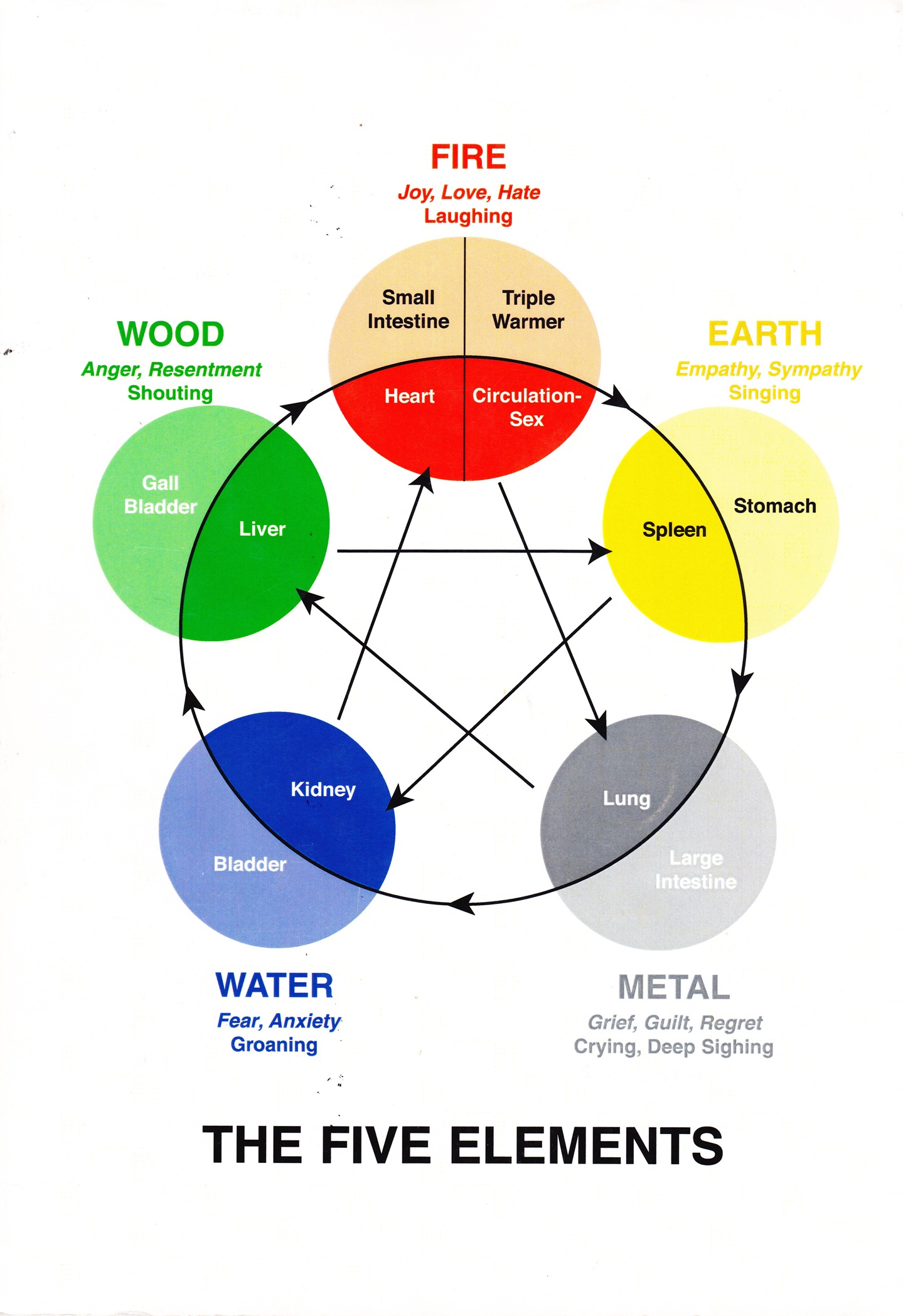Five mouvements of TCM

1 - Wood
Wood is the first element in the cycle of creation (Sheng). It stands for birth, dawn, waking up, the spring and its expansive energy. Its color is green.
The body parts belonging to the Wood element are the muscles, tendons, eyes and the nails.
The Gallbladder stands for the capacity of making decisions and having one’s own needs respected. The Liver comprises the ability of creative imagination and planning one’s own life. Being able to plan a project and to realize it, to have a dream and make it come true are the two main characteristics of the Wood element. If the Gallbladder and the Liver are week, the capacity to express oneself could be inhibited, plans do not get carried out, one has a feeling of being stuck in one’s own life. This may lead to frustration, anger and rage, the emotions belonging to the Wood.
2 - Fire
Fire is the second element in the Sheng cycle of creation. It stands for the apogee, the adult age, the summer, the energy spiking through the earth drawing up towards the heaven like flames do. Its color is red.
The blood vessels, tongue, heart, small intestine and the pericardium belong to the Fire element.
The Heart – called fire the prince or lord of the organs – stands for a clear mind (Shen). The sense of responsibility and enthusiasm are part of it. The Pericardium – called bodyguard of the prince – regulates the cardiac rate and the bloodstream. Being generous and warm with oneself and others, being able to give and receive criticism and love are all part of the Pericardium. If the Heart stands for the psychological side of fire, the Pericardium stands for its physical aspects.
The small Intestine is responsible for absorbing nourishment and new ideas. Sanjiao – sometimes called the triple warmer – is a functional unit assembling the three big “cavities” of the human body: the chest, the belly and the pelvis. Balancing the three of them regulates the respiration rate, digestion, body temperature and equilibrium.
3 - Earth
Earth is the third element of the cycle of creation. It represents maturity, Indian summer, afternoon warmth, abundance, harvest time and the period of establishing winter reserves. Its colors are yellow and brown.
The body parts being part of the Earth element are the mouth, connective tissue, stomach, pancreas and the spleen.
The Pancreas and Spleen stand for logical thinking, the intellect and appropriate criticism. The following are also a part of Earth: reflection, a good memory as well as worries, rumination and nostalgia are as well being part of the Earth.
The Spleen regulates the water and blood distribution in the entire body and has therefore a nourishing function. Consequently, a week Spleen can cause digestive problems, allergies, menstrual pain, edema and complications with the lymphatic system.
The holistic understanding of the Stomach comprises the stomach, the duodenum and the first 15cm of the small intestine. It stands for the absorption of nourishment and is responsible for the regeneration of the body.
4 - Metal
Metal is the fourth element of the Sheng cycle. It stands for late maturity, anticlimax and evening time. Its colors are white and silver. The season of the year being part of the Metal is fall, the time when life forces withdrawal in the nucleus.
The lungs, large intestine, skin and the nose belong to the Metal element. Its force is the concentrated energy, the reduction to the substantial. It is the opposite of the expansive Wood energy.
Through the Lungs, called the Prime Minister of the body in traditional writings, we receive the vital Qi energy (what is called Prana in Hindu tradition). Respiration has the double function of filling the lungs and emptying them, of receiving and letting go, of expanding and contracting. The Lungs stand as well for the relation to the universe, the world and one’s social environment. The large Intestine is capital in eliminating physical and psychological toxins. It is in close relationship with reflection and the capacity of letting go of wishes, expectations and ideas.
5 - Water
Water is the fifth and last element of the Sheng cycle of creation. Water stands for stagnation and decline. On the Sheng cycle of creation, it is situated right before the Wood element that represents a new cycle of life. Water stands for the night and the winter. The life forces retired in the core and are waiting there for the next spring with its expanding life energy to start a new cycle of life. The color of the Water element is black.
The body parts belonging to the Water element are the kidneys, the bladder, the body tissue, the bones, the marrow and the brain.
The force of the Water stands in opposition to the Fire energy. Water energy flows vertically downwards, in depth, to the origins of life.
The Kidneys, called the master inspector of the water distribution system, have a crucial function of continuous purification of the entire organism throughout the water circulation. The Bladder stands for the physical relaxation. It regulates the transition between activity and rest. Being able to surrender, softness and tenderness, not showing any resistance, but going with the flow are all Water qualities.
The Kidneys have together with the Heart an outstanding position in TCM: both of these vital organs are preserving life energy and good health.
In TCM, the meaning of an organ is wider than what we have known from the conventional medicine. In fact, TCM considers an organ in its physiological and psychological meaning, which allows broader and more holistic patient care.